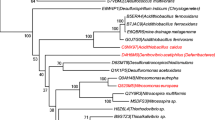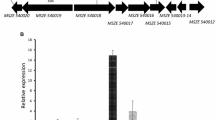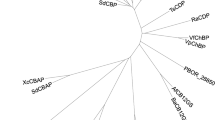Abstract
Sucrose phosphorylase, an important enzyme mainly involved in the generic starch and sucrose pathways, has now caught the attention of researchers due to its transglycosylation activity. A novel sucrose phosphorylase, unspase, has been isolated, and its transglycosylation properties were characterized. Compared with Bisp, the sucrose phosphorylase from Bifidobacterium adolescentis, unspase had two deleted regions in its C-terminal. These deleted regions were probably equivalent to the important five-stranded anti-parallel β-sheet domain in sucrose phosphorylase. Unspase has a km of 21.12 mM, a Vmax of 69.24 μmol min−1 mg−1 and a kcat of 31.19 s−1 with sucrose as substrate. In 3-(N-morpholino) propanesulfonic acid (MOPS) buffer, unspase transferred the glycosyl moiety to l-arabinose, d-fructose and l-sorbose. Much to our surprise, unspase can catalyze the transglycosylation in which a glycosyl moiety was transferred to l-arabinose in the presence of phosphate, which is an interesting exception to the generally accepted fact that transglycosylation can only occur under the condition of phosphate absence. The final yield of the transglycosylation product (37.9 %) in phosphate buffer was even higher than that (5.8 %) in MOPS buffer. This is a novel phenomenon that a sucrose phosphorylase can catalyze a transglycosylation reaction in the presence of phosphate.





Similar content being viewed by others
References
Aerts D, Verhaeghe TF, Roman BI, Stevens CV, Desmet T, Soetaert W (2011) Transglucosylation potential of six sucrose phosphorylases toward different classes of acceptors. Carbohydr Res 346:1860–1867
Birnberg PR, Brenner ML (1984) A one-step enzymatic assay for sucrose with sucrose phosphorylase. Anal Biochem 142:556–561
Blackwell JR, Horgan R (1991) A novel strategy for production of a highly expressed recombinant protein in an active form. FEBS Lett 295:10–12
Broek VLA, Boxtel VEL, Kievit RP, Verhoef R, Beldman G, Voragen AG (2004) Physico-chemical and transglucosylation properties of recombinant sucrose phosphorylase from Bifidobacterium adolescentis DSM20083. Appl Microbiol Biotechnol 65:219–227
Desmet T, Soetaert W (2011) Enzymatic glycosyl transfer: mechanisms and applications. Biocatal Biotransform 29:1–18
Goedl C, Nidetzky B (2010) Carbohydrate synthesis by disaccharide phosphorylases: reactions, catalytic mechanisms and application in the glycosciences. Biotechnol J 5:1324–1338
Goedl C, Schwarz A, Minani A, Nidetzky B (2007) Recombinant sucrose phosphorylase from Leuconostoc mesenteroides: characterization, kinetic studies of transglucosylation, and application of immobilised enzyme for production of alpha-d-glucose 1-phosphate. J Biotechnol 129:77–86
Goedl C, Sawangwan T, Wildberger P, Nidetzky B (2010) Sucrose phosphorylase: a powerful transglucosylation catalyst for synthesis of α-d-glucosides as industrial fine chemicals. Biocatal Biotransform 28:10–21
Ichikawa M, Schnaar RL, Ichikawa Y (1995) Application of sucrose phosphorylase reaction in one-pot enzymatic galactosylation: scavenger of phosphate and generation of glucose-1-phosphate in situ. Tetrahedron Lett 36:8731–8732
Kawasaki H, Nakamura N, Ohmori M, Sakai T (1996) Cloning and expression in Escherichia coli of sucrose phosphorylase gene from Leuconostoc mesenteroides No. 165. Biosci Biotechnol Biochem 60:322–324
Kim M, Kwon T, Lee HJ, Kim KH, Chung DK, Ji GE, Byeon ES, Lee JH (2003) Cloning and expression of sucrose phosphorylase gene from Bifidobacterium longum in E. coli and characterization of the recombinant enzyme. Biotechnol Lett 25:1211–1217
Kwon T, Kim CT, Lee JH (2007) Transglucosylation of ascorbic acid to ascorbic acid 2-glucoside by a recombinant sucrose phosphorylase from Bifidobacterium longum. Biotechnol Lett 29:611–615
Lee JH, Yoon SH, Nam SH, Moon YH, Moon YY, Kim D (2006) Molecular cloning of a gene encoding the sucrose phosphorylase from Leuconostoc mesenteroides B-1149 and the expression in Escherichia coli. Enzyme Microb Technol 39:612–620
Lee JH, Moon YH, Kim N, Kim YM, Kang HK, Jung JY, Abada E, Kang SS, Kim D (2008) Cloning and expression of the sucrose phosphorylase gene from Leuconostoc mesenteroides in Escherichia coli. Biotechnol Lett 30:749–754
Maestre E, Katakis I, Dominguez E (2001) Amperometric flow injection determination of sucrose with a mediated tri-enzyme electrode based on sucrose phosphorylase and electrocatalytic oxidation of NADH. Biosens Bioelectron 16:61–86
Manchenko GP (2003) Handbook of detection of enzymes on electrophoretic gels, 2nd edn. CRC Press LLC, Boca Raton, pp 190–191
Reid SJ, Abratt VR (2005) Sucrose utilisation in bacteria: genetic organisation and regulation. Appl Microbiol Biotechnol 67:312–321
Renirie R, Pukin A, van Lagen B, Franssen MCR (2010) Regio- and stereoselective glucosylation of diols by sucrose phosphorylase using sucrose or glucose 1-phosphate as glucosyl donor. J Mol Catal B Enzym 67:219–224
Russell RR, Mukasa H, Shimamura A, Ferretti JJ (1988) Streptococcus mutans gtfA gene specifies sucrose phosphorylase. Infect Immun 56:2763–2765
Sambrook J, Russell DW (2001) Molecular cloning: a laboratory manual. Cold Spring Harbor Laboratory Press, New York
Schwarz A, Brecker L, Nidetzky B (2007) Acid-base catalysis in Leuconostoc mesenteroides sucrose phosphorylase probed by site-directed mutagenesis and detailed kinetic comparison of wild-type and Glu237– > Gln mutant enzymes. Biochem J 403:441–449
Sugimoto K, Nomura K, Nishiura H, Ohdan K, Hayashi H, Kuriki T (2007) Novel transglucosylating reaction of sucrose phosphorylase to carboxylic compounds such as benzoic acid. J Biosci Bioeng 104:22–29
Sugimura M, Watanabe H, Lo N, Saito H (2003) Purification, characterization, cDNA cloning and nucleotide sequencing of a cellulase from the yellow-spotted longicorn beetle, Psacothea hilaris. Eur J Biochem 270:3455–3460
Tedokon M, Suzuki K, Kayamori Y, Fujita S, Katayama Y (1992) Enzymatic assay of inorganic phosphate with use of sucrose phosphorylase and phosphoglucomutase. Clin Chem 38:512–515
Wechter P, Williamson J, Robertson A, Kluepfel D (2003) A rapid, cost-effective procedure for the extraction of microbial DNA from soil. World J Microbiol Biotechnol 19:85–91
Wiesbauer J, Goedl C, Schwarz A, Brecker L, Nidetzky B (2010) Substitution of the catalytic acid–base Glu237 by Gln suppresses hydrolysis during glucosylation of phenolic acceptors catalyzed by Leuconostoc mesenteroides sucrose phosphorylase. J Mol Catal B Enzym 65:24–29
Acknowledgments
This work was supported by the National Natural Science Foundation of China (31060125) and the Chinese National Programs for Fundamental Research and Development (2010CB736209).
Conflict of interest
The authors declare that they have no conflict of interest.
Author information
Authors and Affiliations
Corresponding author
Additional information
Liqin Du and Hui Yang contributed equally to this work.
Electronic supplementary material
Below is the link to the electronic supplementary material.
Rights and permissions
About this article
Cite this article
Du, L., Yang, H., Huo, Y. et al. A novel sucrose phosphorylase from the metagenomes of sucrose-rich environment: isolation and characterization. World J Microbiol Biotechnol 28, 2871–2878 (2012). https://doi.org/10.1007/s11274-012-1098-y
Received:
Accepted:
Published:
Issue Date:
DOI: https://doi.org/10.1007/s11274-012-1098-y




